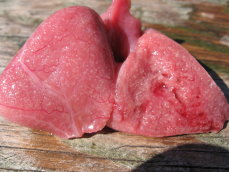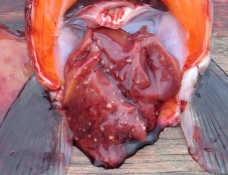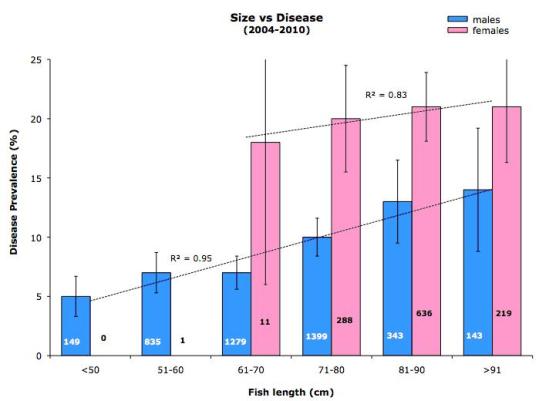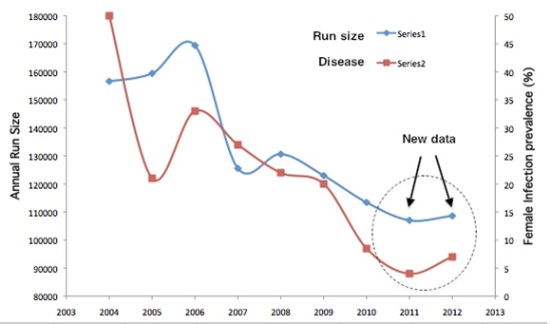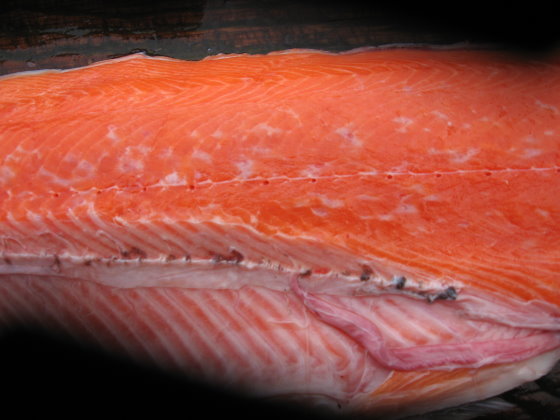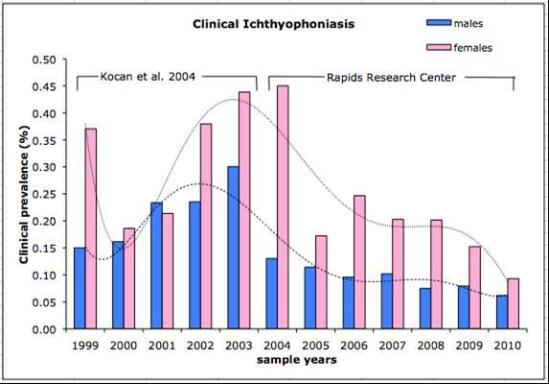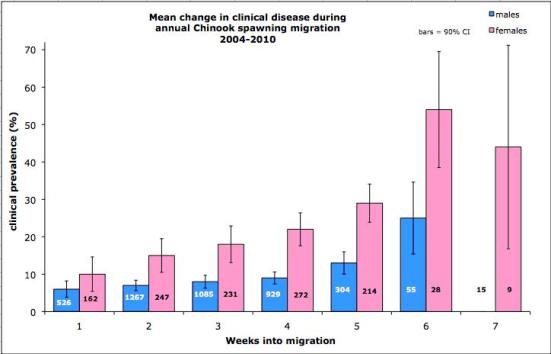|
|
|||||||||||||||||||||||||||||
|
Click on to go to:* Daily Video Project Data Updates Above also found at: |
|||||||||||||||||||||||||||||
|
Listen to
jojobishop@hotmail.com click picture to open |
|||||||||||||||||||||||||||||
|
Contact |
|||||||||||||||||||||||||||||
|
|
|||||||||||||||||||||||||||||
|
In the lower Yukon this disease usually is found in the beginning stages. Fishers often never see the effects and biologists are often unable to accurately detect the infection prevalence. In the middle Yukon the disease starts to become visible in the heart and flesh of those infected, and infection and disease prevalence can now be accurately looked at. Prevalence has been as high as 45% in females some of the monitored years but some of the worse years were prior to any monitoring in the early and mid 1990’s. In the upper Yukon around the confluence of the Tanana River and above each year, it’s severity is often the reason the Chinook subsistence fishery ends before the Chinook stop running. In the headwaters and spawning grounds exists the political/biological question of whether all those diseased fish made it or not, and the effects on present day runs. Ichthyophonus today is one of the most divisive issues in the drainage. Marketing, management, subsistence interests, and even “scientific” research all seem to get caught in it grips. Below are some of the media stories that have come out about ICH. Link to Los Angeles Times National News Story and Video (June 15, 2008): Los Angeles Times reporter Ken Weiss talks with Bruce Gellerman Link to Alaska Public Radio Interview (February 29, 2008): Sometimes it takes good eyes to see the smaller Ichthyophonus “spores” in hearts. Click on left picture to view enlarged picture and see ICH. Right picture is a diseased liver with large “spores” (both Chinook) With the disease’s tendency to advance much faster in the larger salmon one can wonder (along with other possible factors) how much it is linked to the decline and present day lack of the older Chinook age classes (see graph below). While the problem of Chinook size decline started around the time Ichthyophonus disease in the Yukon became pronounced, present studies, data collection and monitoring are not consistent or focused enough to speak to that issue
One of the latest findings was published in a recent article in the Transactions of the American Fisheries Society (Zuray et al. 2012) and described a multi-year epidemiologic study of ichthyophoniasis in Yukon River Chinook salmon from 1999 to 2010 that revealed a strong correlation between changes in disease prevalence and population abundance. Both run size and ichthyophoniasis increased and decreased simultaneously (i.e. were concordant); the greatest concordance occurring among females, where the two values rose and fell synchronously for 10 of 11 years (91%) (X2 = 0.003). Although there was no cause-and-effect relationship, the strong correlation between the two values made it a good model for predicting changes in run size based on increases or decreases in ichthyophoniasis (and visa versa). Since 2010 two additional years of data were added to the model, and as predicted, when ichthyophoniasis increased, so did run size, and when it fell, run size declined. The graph below compares data on increases/decreases in disease and run size from 2004 through 2012 showing the continuing correlation between ichthyophoniasis and run size.
It is generally thought that water temperature in the Yukon River during the migration
Below graph is a 12-year summary of clinical ichthyophoniasis in Yukon River Chinook salmon collected during two consecutive studies. Infection prevalence peaked in 1999, 2003 and 2006, followed by a steady decrease through 2010. While no data exists for years prior to 1999 most fishermen remember the mid 90’s as being the worse with large amounts of diseased king being discarded and prevalence in females well beyond 50%. The disease will continue running it’s course each year. Hopefully after numbers of fish generations the Chinook will build a resistance to it. Because of variables of water temperature and what part of the run the fish migrates upriver in (see graph below) is very important to do consistent, yearly, full season disease monitoring, and disease prevalence testing upriver of the mouth. Without these basics we’ll have no more of an educated idea of it’s effects in the future than we do of it’s past and present. Above graph shows change in clinical Ichthyophoniasis (%) in Yukon River Chinook salmon during their upriver spawning migration. The increase in disease prevalence corresponds with the observations of local fishers who annually report higher numbers of diseased fish near the end of the run.
Yukon River Chinook Ichthyophonus Reports Note: Some of the below reports are published peer reviewed papers, others are simply project reports or critical reviews of those reports. In order to better understand this divisive issue an effort will be made to list a variety of differing opinions. Please contact for inclusion of any you think valuable.
|
| [Home] [Rapids Video Project] [Yukon River Panel] [Fish Friendly] [Video Equipment] [Reports] [Data] [Project History] [Current Issues] [Ichthyophonus Disease] [Chinook Size Decrease] [Customary Trade] [Ocean Bycatch] [Subsidized Hatcheries] [Student Data Project] [Chum Tag Project] [Fish Links] [Fishwheels] [Subsistence Activities] [Commercial Fishing] |

